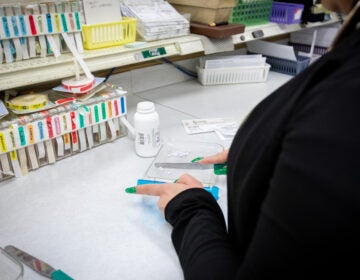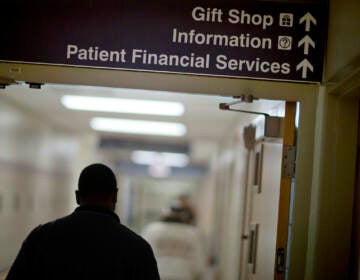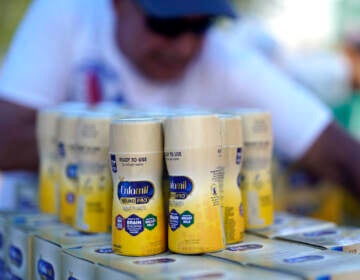Ozempic’s popularity leads to shortages for people with Type 2 diabetes
These medications have been so wildly successful that the drugmakers can’t keep up with demand.

A T-shirt from fashion brand Namilia shown during Berlin Fashion on July 3, 2024 sparked an outcry on the brand's Instagram, with readers noting that Ozempic is in short supply for people with a medical need for it. (Sebastian Reuter/Getty Images)
Jim Cox had heard of people with Type 2 diabetes who were unable to get Ozempic because the drug was being used off-label for weight loss. He just didn’t think the shortage would affect him.
He has the disease too, but he takes a different drug called Trulicity, which is in the same class of GLP-1 drugs as Ozempic.
But “then I went up to my local pharmacy to get my Trulicity and they said, ‘Sorry, we’re out,’” Cox says. “I couldn’t renew my prescription.”
Cox says the pharmacist suggested calling a few times a week to see if the drug was back in stock. He wound up needing to ration his Trulicity to make it last longer.
“There’s people worse off than me that need this stuff, and it’s their lifeline,” he says.
He’s right. Missing doses can lead to uncontrolled blood sugar for people with Type 2 diabetes, and that can snowball into kidney and eye complications, for example. Trulicity and similar diabetes drugs like Ozempic and Mounjaro, have all been in short supply over the last 18 months.
Patients can’t fill prescriptions
Telehealth company Ro built a free online tool to help patients report shortages of these drugs. Every few seconds, the map lights up with a little lightning bolt, indicating someone at that location went to their pharmacy to get their weight loss or diabetes drug and couldn’t fill the prescription.
The tracker received 35,000 reports of shortages by mid-June, within the first two weeks of its launch, says Ro’s CEO Zach Reitano. “It’s sad that we received that many.” The tool, which is available even to those who aren’t Ro.co customers, also tells people when it finds a supply of their GLP-1 drug within 100 miles of where they live.
These medications have been so wildly successful that the drugmakers can’t keep up with demand, says Boston University health economist Rena Conti.
“They should have been prepared to meet demand given their very aggressive advertising campaigns,” Conti says.
“This is kind of an unprecedented situation in that these are drugs that are very heavily used to manage a very serious condition, diabetes,” she says, adding that obesity is also a serious metabolic condition. “The demand that is coming from weight loss and coming from off-label use is also real.”
Still, Ozempic’s immense popularity, fueled by Hollywood, social media influencers and ubiquitous ads on social media, means there are also people taking these drugs who want to lose a few pounds for cosmetic reasons.
“If someone is morbidly obese, they have every right to use that drug for weight loss,” says Cox, the Type 2 diabetes patient who couldn’t fill his Trulicity prescription. “I have no issue with that. It’s the people that are doing it strictly for about 8,10, 12, 20 pounds.”
And the drugmakers’ own TV advertisements about GLP-1 drugs approved to treat Type 2 diabetes include language about how many pounds patients lost, even though that’s not officially what those drugs are for.
This kind of advertisement makes Cox angry.
“They just went overboard,” he says. “And they saw dollar signs and they went for it and they didn’t consider the fact that they are hurting their base clientele, their patients.”
Eli Lilly, which makes Trulicity and Mounjaro, has made public statements against using GLP-1 drugs for “cosmetic weight loss” and other inappropriate uses. And Novo Nordisk, which makes Ozempic, says its advertising is meant to educate patients, not promote off-label use.
“Although Wegovy and Ozempic both contain semaglutide, they are different products with different indications, dosages, prescribing information, titration schedules, and delivery forms,” Eric Althoff, speaking on behalf of Novo Nordisk, wrote in an email to NPR. “The products are not interchangeable and should not be used outside of their FDA-approved indications.”
Which patients should get priority?
Still, it turns out that conserving medicines for the people they were approved to treat is challenging.
At CVS Caremark, a pharmacy benefit manager, the solution involves looking at a patient’s history with the company to see whether there’s any prior evidence of them having diabetes. About a third of the time there isn’t, says Dr. Daniel Knecht, chief innovation officer at CVS Caremark, and then the company will require a prior authorization, asking the doctor to justify the prescription.
“For those prescribers that go ahead and fill out that prior authorization, we’re rejecting about 84%, meaning that most of those patients are not actually diabetic and there is off-label use,” he says.
Some doctors say that CVS Caremark’s approach might cause more problems, however.
Dr. Scott Isaacs, the president-elect of the American Association of Clinical Endocrinology, says there’s a lot of overlap between patients with Type 2 diabetes and patients who need GLP-1s for weight loss. Still, he says he might prescribe a diabetes drug to a weight-loss patient and vice versa — he’ll prescribe whichever drug is available and covered by the patient’s insurance.
He’s upset about a troubling trend at the pharmacy counter.
“I feel like it’s obesity discrimination,” he says. “They would tell patients things like, you know, you don’t deserve to be on this or, you know, this is for patients with diabetes, you’re abusing this drug even if the doctor is prescribing it.”
While a person who has diabetes could have a more immediate response to missing a dose of one of these drugs, Isaacs says both groups of patients really do need their medicines.
It’s unclear how soon the shortages will be resolved, but the drugmakers have invested in new factories and say they’re ramping up production.

Get daily updates from WHYY News!
WHYY is your source for fact-based, in-depth journalism and information. As a nonprofit organization, we rely on financial support from readers like you. Please give today.




